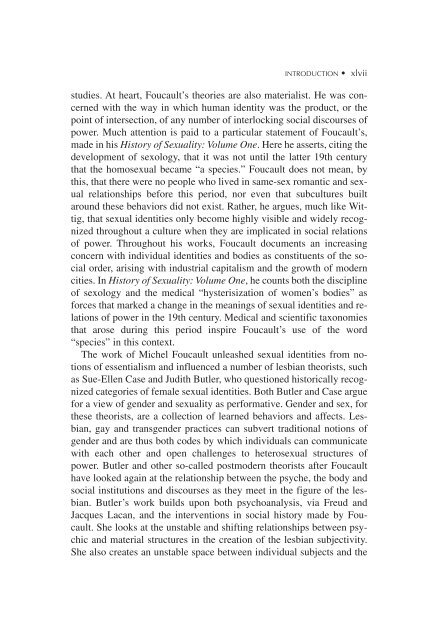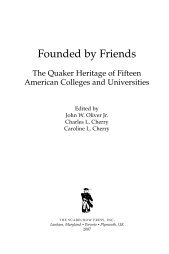Historical Dictionary of Lesbian Literature - Scarecrow Press
Historical Dictionary of Lesbian Literature - Scarecrow Press
Historical Dictionary of Lesbian Literature - Scarecrow Press
You also want an ePaper? Increase the reach of your titles
YUMPU automatically turns print PDFs into web optimized ePapers that Google loves.
INTRODUCTION • xlvii<br />
studies. At heart, Foucault’s theories are also materialist. He was concerned<br />
with the way in which human identity was the product, or the<br />
point <strong>of</strong> intersection, <strong>of</strong> any number <strong>of</strong> interlocking social discourses <strong>of</strong><br />
power. Much attention is paid to a particular statement <strong>of</strong> Foucault’s,<br />
made in his History <strong>of</strong> Sexuality: Volume One. Here he asserts, citing the<br />
development <strong>of</strong> sexology, that it was not until the latter 19th century<br />
that the homosexual became “a species.” Foucault does not mean, by<br />
this, that there were no people who lived in same-sex romantic and sexual<br />
relationships before this period, nor even that subcultures built<br />
around these behaviors did not exist. Rather, he argues, much like Wittig,<br />
that sexual identities only become highly visible and widely recognized<br />
throughout a culture when they are implicated in social relations<br />
<strong>of</strong> power. Throughout his works, Foucault documents an increasing<br />
concern with individual identities and bodies as constituents <strong>of</strong> the social<br />
order, arising with industrial capitalism and the growth <strong>of</strong> modern<br />
cities. In History <strong>of</strong> Sexuality: Volume One, he counts both the discipline<br />
<strong>of</strong> sexology and the medical “hysterisization <strong>of</strong> women’s bodies” as<br />
forces that marked a change in the meanings <strong>of</strong> sexual identities and relations<br />
<strong>of</strong> power in the 19th century. Medical and scientific taxonomies<br />
that arose during this period inspire Foucault’s use <strong>of</strong> the word<br />
“species” in this context.<br />
The work <strong>of</strong> Michel Foucault unleashed sexual identities from notions<br />
<strong>of</strong> essentialism and influenced a number <strong>of</strong> lesbian theorists, such<br />
as Sue-Ellen Case and Judith Butler, who questioned historically recognized<br />
categories <strong>of</strong> female sexual identities. Both Butler and Case argue<br />
for a view <strong>of</strong> gender and sexuality as performative. Gender and sex, for<br />
these theorists, are a collection <strong>of</strong> learned behaviors and affects. <strong>Lesbian</strong>,<br />
gay and transgender practices can subvert traditional notions <strong>of</strong><br />
gender and are thus both codes by which individuals can communicate<br />
with each other and open challenges to heterosexual structures <strong>of</strong><br />
power. Butler and other so-called postmodern theorists after Foucault<br />
have looked again at the relationship between the psyche, the body and<br />
social institutions and discourses as they meet in the figure <strong>of</strong> the lesbian.<br />
Butler’s work builds upon both psychoanalysis, via Freud and<br />
Jacques Lacan, and the interventions in social history made by Foucault.<br />
She looks at the unstable and shifting relationships between psychic<br />
and material structures in the creation <strong>of</strong> the lesbian subjectivity.<br />
She also creates an unstable space between individual subjects and the
















